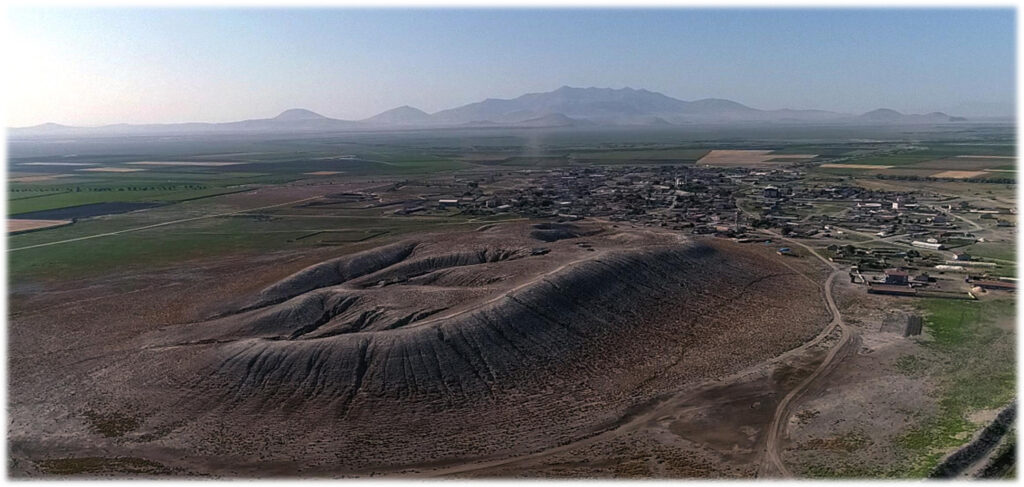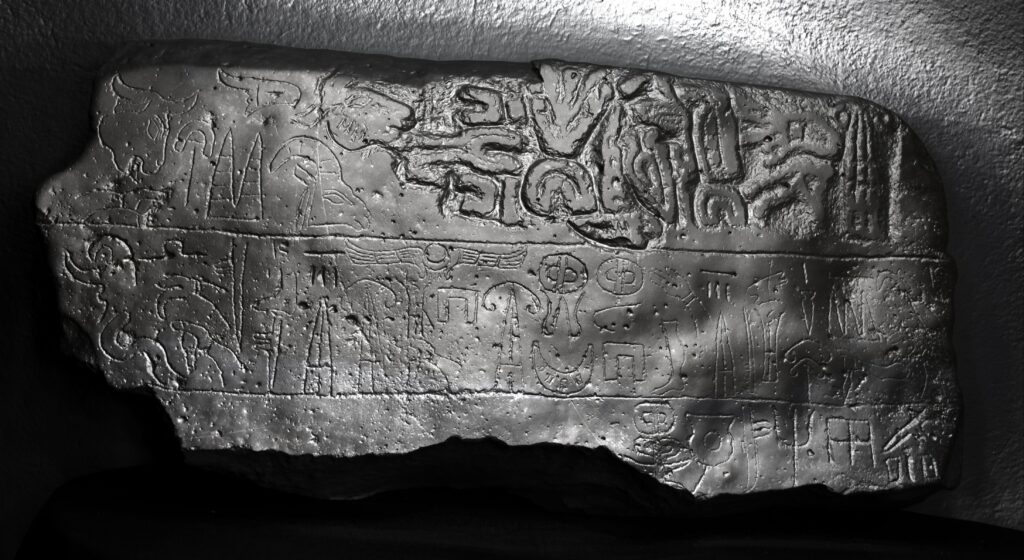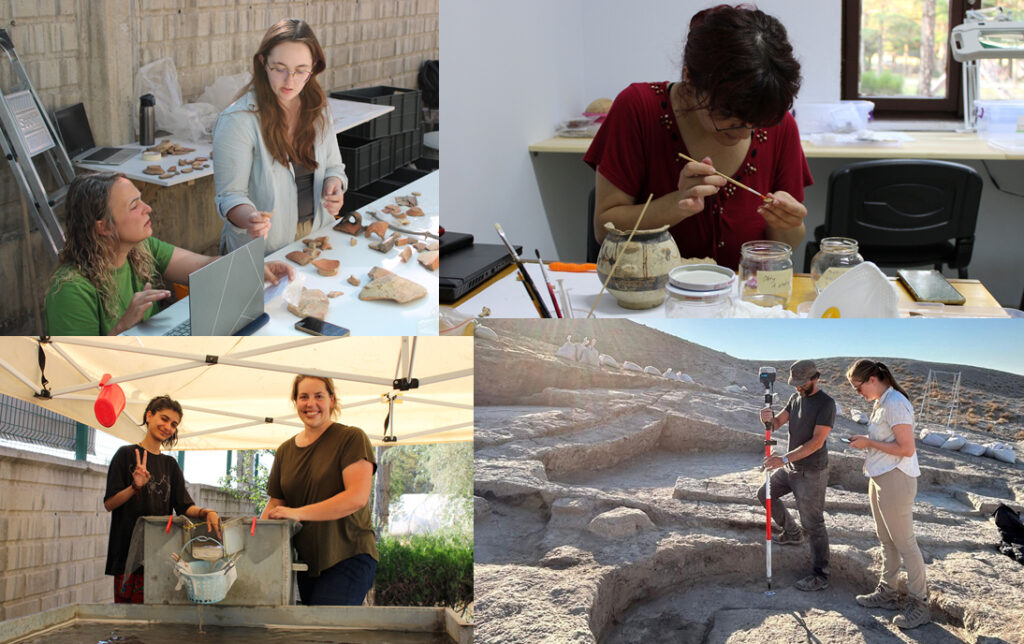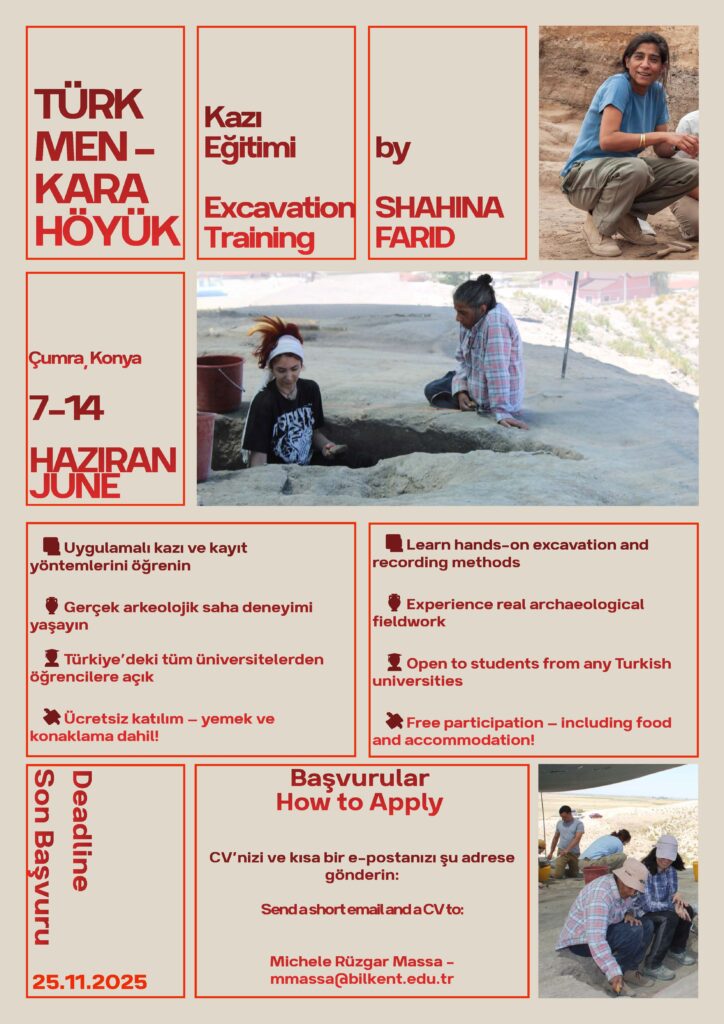
The Türkmen-Karahöyük Archaeological Project (TKAP) is a long-term research program in the Konya Plain that is supported by Bilkent University and the University of Chicago. The project began in 2024 with the permission of Türkiye’s Ministry of Culture and Tourism and is co-directed by Michele Rüzgar Massa (Bilkent University) and James Osborne (University of Chicago), with Hüseyin Erpehlivan (Bilkent Şeyh Edebali University) serving as the assistant director.
TKAP aims to:
- Understand the role of Türkmen-Karahöyük in the trajectories of sociopolitical complexity in Anatolia, from the first cities to the first empires, and its evolving relationship with the surrounding environments
- Build an innovative, interdisciplinary research pole in the region
- Create a training centre for a new generation of Anatolian archaeologists
- Promote knowledge co-production with local communities living by the site.
History of the site
Türkmen-Karahöyük is one of the largest settlements in pre-Roman Anatolia (figure 1), with a seemingly continuous occupation spanning from the Early Bronze Age to the end of the Hellenistic period (ca 3000-50 BCE).

Figure 1. General plan of the site.
Multi-disciplinary analyses on finds from the excavated trenches reveal that it was already a significant trade hub in the early 2nd millennium BCE, with exotic fruits, perfumes and fine wares imported from the Mediterranean coast and beyond. It later became an important administrative centre under the Hittite Empire, and current research suggests it may have been the location of the second Hittite capital, Tarhuntassa. A key piece of evidence for the site’s later history comes from an inscription written in Anatolian Hieroglyphic, commissioned by a Great King Hartapu who claims to have won a battle against the kingdom of Phrygia around 750 BCE (figure 2). This inscription strongly suggests Türkmen-Karahöyük as the likely capital of the Iron Age kingdom ruled by Hartapu. The settlement reached its greatest extent during the Achaemenid and Hellenistic periods (ca. 550–50 BCE), featuring extensive off-site cemeteries and a large lower town. From this period, finds like precious perfume bottles, inkwells and styluses, a terracotta bathtub, and a frescoed room (figure 3) witness the presence of elite families at the site. Around the late 2nd-early 1st centuries BCE, the city was destroyed by a fire conflagration, likely coinciding with the Roman conquest of the region. A few generations after that, for reasons still unknown, Türkmen-Karahöyük was abandoned as the city of Konya started to grow as the new urban site in the region.

Figure 2. Anatolian Hieroglyphic inscription mentioning Great King Hartapu.

Figure 3. Reconstruction of the frescoed room in Field 6.
The project
TKAP brings together a large international team of over 100 researchers, with 60% from Türkiye and experts representing a dozen other nationalities (figure 4). One of TKAP’s central aims is to serve as a laboratory for cutting-edge archaeological research in Anatolia. This is achieved through a firm commitment to scientific interdisciplinarity and by fostering a positive, inclusive, and collaborative work environment for participants at all levels of experience. The excavation team is supported by over 40 specialists who investigate every aspect of ancient life — from plant, animal, and human remains to pottery, architecture, biochemistry, conservation, history, technology, and community archaeology.

Figure 4. Team photo in 2025 (second session).
TKAP embraces the principle that collaborative science produces more effective and exciting results. A key tool supporting this collaboration is a custom-designed database, in which both field and laboratory data are entered in real time. This system allows continuous interaction between excavators and specialists, enabling field strategies to adapt dynamically to emerging research questions. Following a model first developed in this region by the Çatalhöyük excavation team, TKAP integrates a wide array of scientific techniques to advance new interpretations of the past. Reflecting the project’s commitment to a truly interdisciplinary approach, TKAP has a range of specialist laboratories, including Archaeobotany, Archaeometry, Ceramics, Community Archaeology, Conservation, Digital Database, Finds, Geomatics, Human Osteology, Palaeoenvironment, Photography, and Zooarchaeology (figure 5).

Figure 5. Interdisciplinary research at Türkmen-Karahöyük.
Public outreach
Among TKAP ’s primary objectives are to strengthen the relationship between the project team and the local community, increase public interest and participation in archaeology, and raise public awareness of the project through public events and media channels, ultimately with the goal of fostering genuine collaboration with the people living by Türkmen-Karahöyük. The Community Archaeology Laboratory organises school presentations to introduce children to archaeology (Figure 6), while site tours of the excavated trenches and visits to the TKAP laboratories allow adults to gain a deeper understanding of the work of the TKAP team. We also reach wider audiences through media partnerships and an active social media presence (see our Instagram account), ensuring that the project’s work is accessible, visible, and rooted in local voices.
In parallel, there are plans to establish a new visitor centre in Çumra (a smaller facility within the next 4–5 years, and a larger museum and research complex within a decade) to share the extraordinary story of Türkmen-Karahöyük with the wider public.

Figure 6. Archaeology Day at the Türkmenkarahüyük elementary school.
Training opportunities
Training is at the heart of the TKAP ethos. Each season, students receive structured instruction in both field and laboratory methods. Mornings are dedicated to supervised excavation, where participants learn stratigraphic recording, context management, and responsible recovery techniques directly in the field. Afternoons shift to laboratory-based training, including finds processing, cataloguing, and basic analytical skills, ensuring a full understanding of the excavation workflow. Beginning in 2025, TKAP also offers an intensive, week-long Excavation Training led by renowned field archaeologist Shahina Farid, providing students with advanced guidance grounded in decades of professional experience (figure 7).

Figure 7. Flyer for the 2026 TKAP Excavation Training.
To ensure a safe, respectful, and enjoyable working environment, TKAP has also developed a Code of Conduct that promotes responsible behaviour and accountability among all participants.
Institutional support
The project is funded by the University of Chicago, Bilkent University, and other international institutions including Oxford University, New York University, the University of Pavia, the British Institute at Ankara, the Merops Foundation, the Konya Büyükşehir Belediyesi Kültür Sanat Şube Müdürlüğü, as well as by private sponsors Catherine Novotny and Sok Nam.
TKAP in the media
Heritage Türkiye (BIAA) Podcast – A New Excavation in Central Anatolia with Michele Rüzgar Massa
Istituto di Cultura Italiana – 16th Convegno Archeologico dell’IIC di Istanbul (In Turkish):
https://www.youtube.com/watch?v=p6SU6KkuWSA&t=5988s (1:39:50)
Arkeofili: – Konya’daki Türkmen Karahöyük’te Mühürler, Zarlar ve Kalem!
DHA – 18 August 2025:
TRT Haber – 23 August 2024
https://x.com/trthaber/status/1827010155092865070?t=lKk7sAnTvqgh7lFWlsic_w&s=19
Selected Publications
Creamer, P., J. Alperstein, M. Massa, J. Osborne, and J. Casana (2025). Magnetic Gradiometry Survey at the Urban Centre of Türkmen-Karahöyük (Turkey), Archaeological Prospection 32(2): 249-261.
Goedegebuure, P., T. van den Hout, J.F. Osborne, M. Massa, C. Bachhuber, and F. Şahin (2020). TÜRKMEN-KARAHÖYÜK 1: A New Hieroglyphic Luwian Inscription from Great King Hartapu, son of Mursili, Conqueror of Phrygia, Anatolian Studies 70: 29-43.
Massa, M., and J.F. Osborne (2024). Kızıldağ, Karadağ, and Sacred Peak Sites in Central Anatolia during the Late Bronze and Iron Ages, American Journal of Archaeology 128 (1): 33-58.
Massa, M., C. Bachhuber, F. Şahin, H. Erpehlivan, J. Osborne, and A.J. Lauricella. (2020). Urbanisation and State Formation in the Central Anatolian Bronze and Iron Ages: A Regional Perspective from the Konya and Karaman Plains, Anatolian Studies 70: 45-75.
Osborne, J. F., M. Massa, F. Şahin, H. Erpehlivan, and C. Bachhuber (2020). The City of Hartapu: Results of the Türkmen-Karahöyük Intensive Survey Project, Anatolian Studies 70: 1-27.
